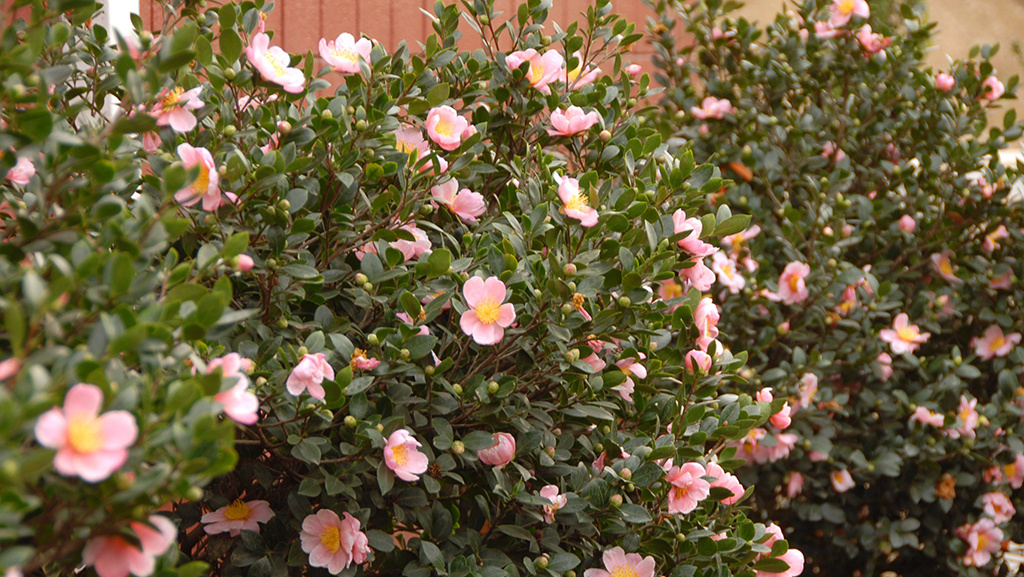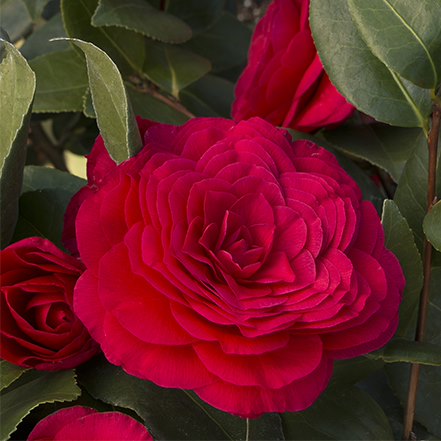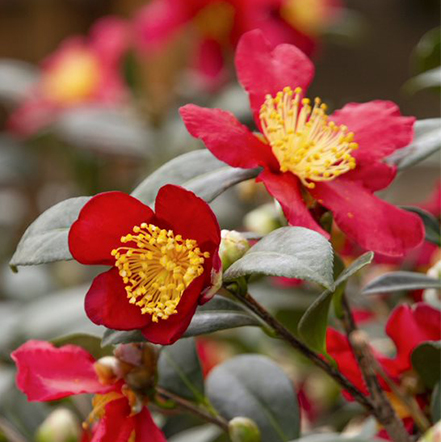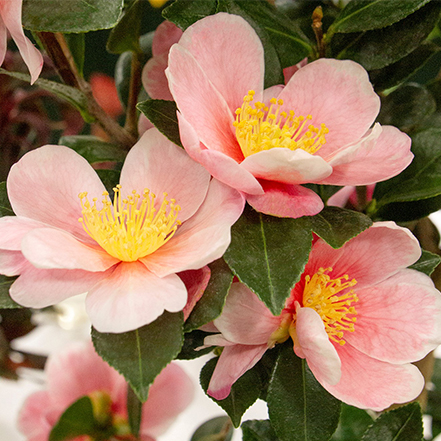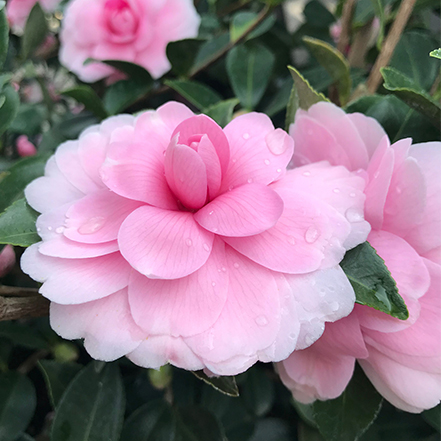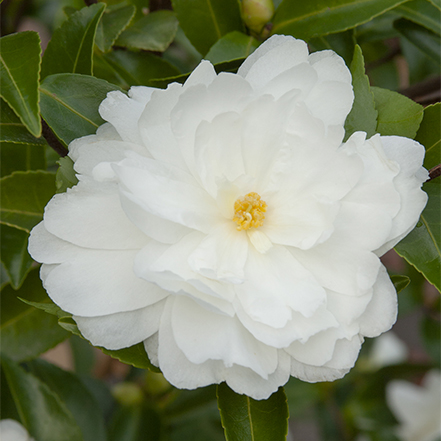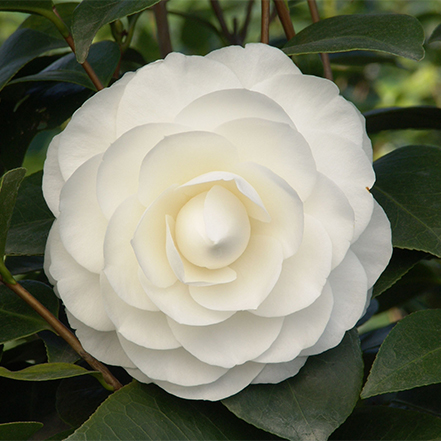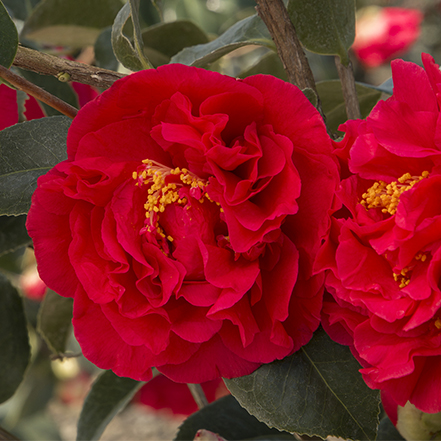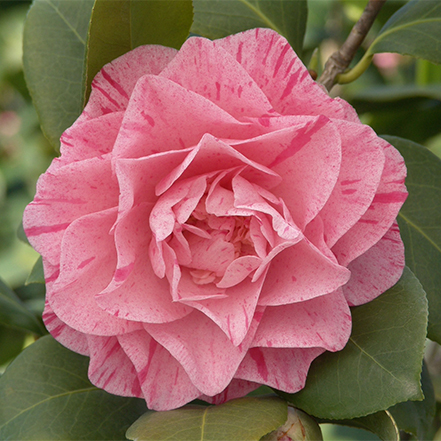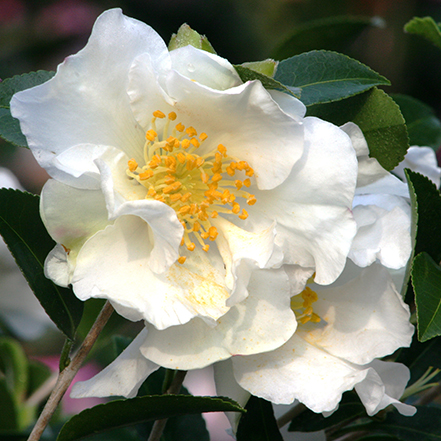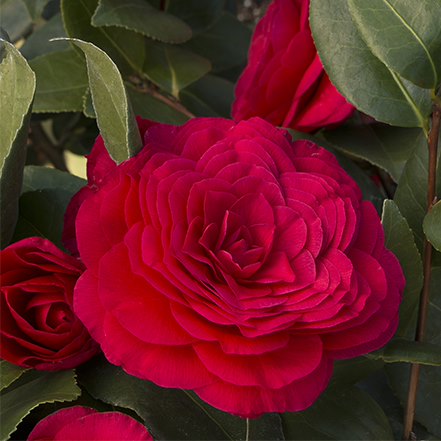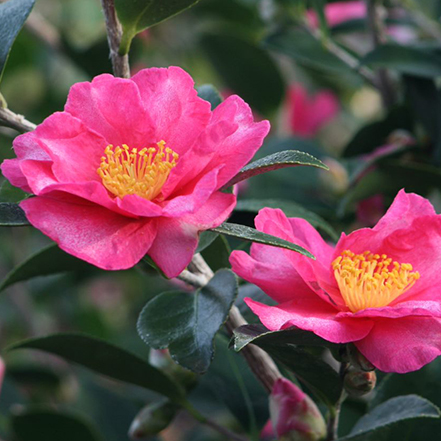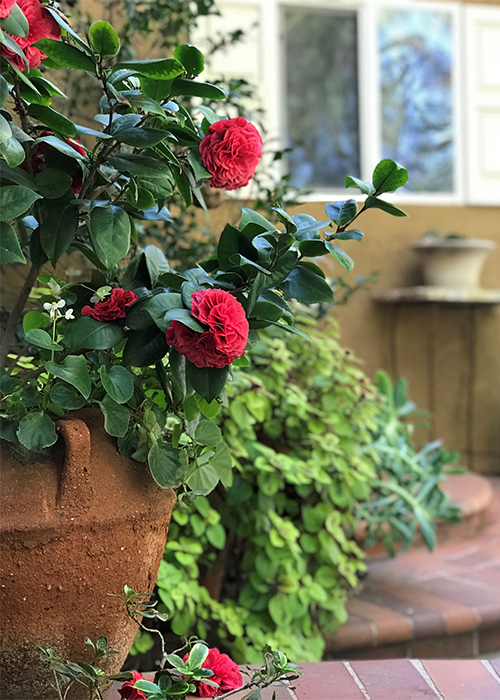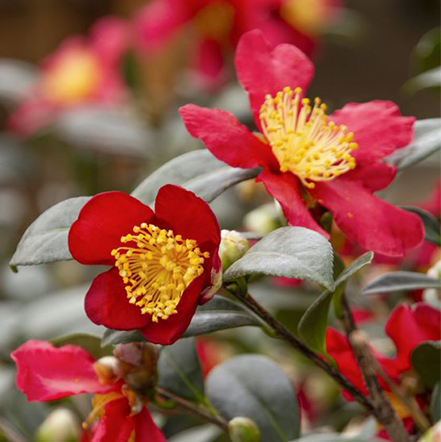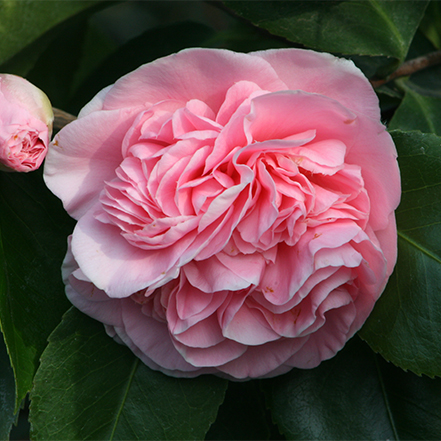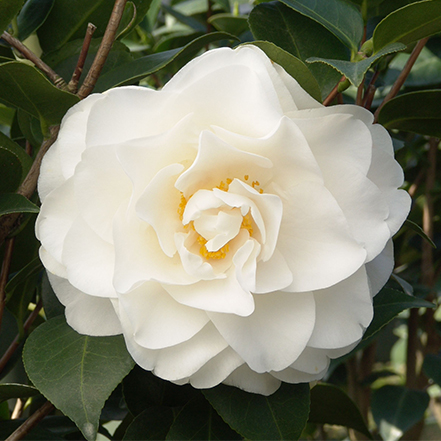Known for their impressive display of flowers and glossy, deep-green leaves, camellias are considered by many as a must-have ornamental shrub. Although camellias lean more traditional in style, if the conditions are right, most any garden would benefit from them. With the right mix of varieties, their long-lasting blooms can provide profuse pops of color from fall into spring.
Beyond their aesthetic beauty, camellias are also dependable utility players in the garden. Various sizes and a structured, evergreen habit make them an adaptable choice. They'll establish the bones of your landscape beds, provide screening, or soften the corners and foundation of your home. Camellias are wonderful when planted in large sweeps, small groupings, or as a specimen plant. They can also be planted in containers, trained as espalier, and even be made into tree-form.
Table of Contents:
- What's the Difference Between Camellia japonica and Camellia sasanqua?
- Where and How to Plant Camellias
- Camellia Care Tips
- How to Grow Camellias in Pots
This care guide offers everything you need to know to grow camellias confidently. We'll cover a number of helpful topics, including pruning, fertilizing, and growing camellias in pots. (See the table of contents and skip ahead if you have specific questions).
The Monrovia Difference (look for the green pot)
All camellias you see in the classic Monrovia green pot have been hand-tended. They've also been specially grown to become fuller, faster in your garden. Monrovia craftsmen take the time (years, in fact) to nurture them to be full, bushy, and laden with flower buds. Take a look next time you shop to see how they stand out. The custom soil mix you'll also find in their classic green pots contains beneficial fungi. This is to help them continue to thrive in your garden.
Understanding The Different Types Of Camellias
Flowered camellias have been beloved by gardeners for centuries, captivating enthusiasts with their blooms and foliage. These evergreen shrubs or small trees are native to East Asia and are known for their stunning blooms and glossy leaves. The camellia genus includes over 300 species, with Camellia japonica, Camellia sasanqua, and Camellia sinensis being among the most popular. Camellias are prized for their long-lasting flowers, which come in a variety of colors, including white, pink, red, and even yellow. These plants are often associated with elegance and refinement, making them a favorite in many gardens around the world.
What's the Difference Between Camellia japonica and Camellia sasanqua?
Nuccio's Bella Rossa Camellia is a Camellia japonica
Yuletide Camellia is a Camellia sasanqua
There are over 250 species of camellia, with over 3,000 cultivars and hybrids to choose from. Camellia japonica and Camellia sasanqua are the most popular for home gardens and landscapes. They are more similar than dissimilar, which makes it difficult to tell them apart. The primary difference is when they bloom.
Depending on climate and cultivar, sasanquas typically bloom from mid-fall into winter, while japonicas bloom from winter into early spring. Regardless, either species will brighten up a garden with a burst of color, especially when most other plants are enjoying their winter break. These colors include shades of red, rose, pink, purple, and white, and some are even bi-colored.
Other differences between Camellia japonicas and sasanquas include:
Sun exposure: Although all camellias prefer at least partial shade, sasanquas are typically more tolerant of sun than japonicas.
Hardiness: Likewise, sasanquas typically grow better in hotter conditions, while japonicas are more cold hardy.
Size: Japonicas are generally larger than sasanquas, both in size as well as the size of their leaves and blooms (up to 5" vs. sasanquas' 2" - 4" blooms).
Flowers: Besides being smaller, sasanqua flowers often have a sweet scent, while japonicas do not. But to make up for their lack of fragrance, japonica blooms typically have more petals.
Given these minor differences, camellias are typically chosen based on flower color first. That said, consider choosing selections of both sasanqua and japonica, with varying bloom times, to optimize your garden’s flower power. From there, consider sun exposure and the size of the plant needed for your spot. Sasanquas are often chosen for tighter spaces that have more sun exposure. Japonicas are chosen for shadier spots where there's more room to grow.
Three Favorite Camellia sasanqua Varieties
Pink-A-Boo®
Camellia
This stunning sport from the extremely popular red Yuletide Camellia has large, wonderfully fragrant, deep-pink blooms. With bright yellow stamens, making a beautiful addition to the cool-season garden. Full shade to partial sun. Up to 10' tall and wide in 10 years. Zones 7-10.
Chansonette's
Blush Camellia
A delightful new color variation on a favorite. This showy, low-growing camellia displays profuse, soft pink flowers on glossy dark green leaves. Flowers are perfect for cutting. Full shade to partial sun. Up to 10’ tall and wide. Zones 7-10.
White Doves
Camellia
Sparkling white, semi-double blooms cover glossy dark green foliage during the cool season. Upright, somewhat willowy branches form a handsome rounded shrub with age. Full shade to partial sun. Up to 9' tall and wide. Zones 7-10.
Three Favorite Camellia japonica Varieties
Nuccio's Gem
Camellia
Sparkling white, formal, double blooms contrast well with the glossy, dark green foliage. This winter bloomer is a prized plant of the milder regions of the U.S. Up to 8' tall and wide. Zones 8-10.
Kramer's Supreme
Camellia
Deep-red buds open to magnificent peony-like, rosy-red flowers with a delightful fragrance. The red blooms create a dazzling contrast against the glossy, dark green foliage. Full to partial shade. Up to 8' tall. Zones 8-10.
Carter's Sunburst
Camellia
Spectacular, double, medium pink blooms streaked with deeper pink. These add early-season color to shady areas in late winter to early spring. Full shade to partial sun. Up to 8' tall and wide. Zones 8-10.
Where and How to Plant Camellias
Although camellias sometimes get a bad rap for being difficult to grow, if they're planted appropriately and in the right spot they can be the most dependably happy plants in your garden.
Here are several things to keep in mind when planting your camellias:
Planting Times
Choosing the right time to plant your camellias can greatly impact their success:
- Fall: Generally the best time, allowing roots to establish before summer heat.
- Early Spring: Preferable in regions with severe winters.
- Late-season Bloomers: Plant at least six weeks before the first frost.
- Container Planting: More flexible timing, but requires vigilant moisture management.
Sun Exposure
Camellias need to be protected from the scorching afternoon sun. So, to ensure healthier plants and better flowers, choose a spot that may get morning sun but dappled shade in the afternoon. The light of a woodland garden is the perfect setting. As they mature, camellias can tolerate more sun.
Soil
Camellias perform best in well-drained, slightly acidic soil (pH of 5.5 to 6.5):
- If you’re uncertain how acidic your soil is, you can always test it. Then, based on the results, amend the soil accordingly. (E.g., add organic matter or peat moss when planting to make the soil more acidic).
- If a given spot is often soggy, choose another plant—camellias hate wet feet!
Planting Care
Camellias can be a bit finicky if planted too deeply or by adding too much mulch.
- Plant your camellias a bit higher than the ground they are placed in. Leave an inch or 2 of the root ball from the pot above grade. Then grade the surrounding soil up to it, but not covering it.
- Add only about an inch or 2 of leaf litter or organic mulch (e.g., pine bark). Doing so will provide them with the nutrient boost they'll need to get established and improve drainage. But don’t add too much mulch or you’ll increase the chances of disease. To further minimize the chances of disease, keep the mulch 3 to 4 inches from the trunk of the plant.
How to Care for Camellias
Once in the ground, your camellias still need to be properly cared for. Below you will find some helpful camellia care tips.
How and When to Water Camellias
Like most plants, camellias need to be watered regularly to establish their root systems.
Here are five tips for watering camellias:
- Rainwater is best since it’s slightly acidic. But if Mother Nature doesn’t cooperate, watering twice a week for a total of 1” is recommended.
- Keeping the soil moist during dry periods will help with plant development and bloom production. It will also minimize the chances of a spider mite infestation, a pest common to camellias.
- Use a soaker hose, drip-watering system, or aim the water at the base of the plant. This is best to avoid getting the foliage wet, thereby minimizing the chances of fungal diseases.
- Always make sure that the water drains well.
- Once mature (3 years old), camellias need little supplemental watering.
Common Pests and Diseases of Camellias
Camellias can face several challenges, but with proper care, you can keep them healthy:
- Tea Scale: Tiny specks on leaf undersides causing yellowing. Treat with horticultural oil.
- Petal Blight: Causes brown, dropping flowers. Remove affected blooms and replace mulch.
- Leaf Gall: Creates distorted leaves. Remove and destroy affected leaves.
- Dieback and Canker: Most serious. Prune diseased areas and consider copper fungicide.
Regular inspection and prompt action are key to maintaining thriving camellias.
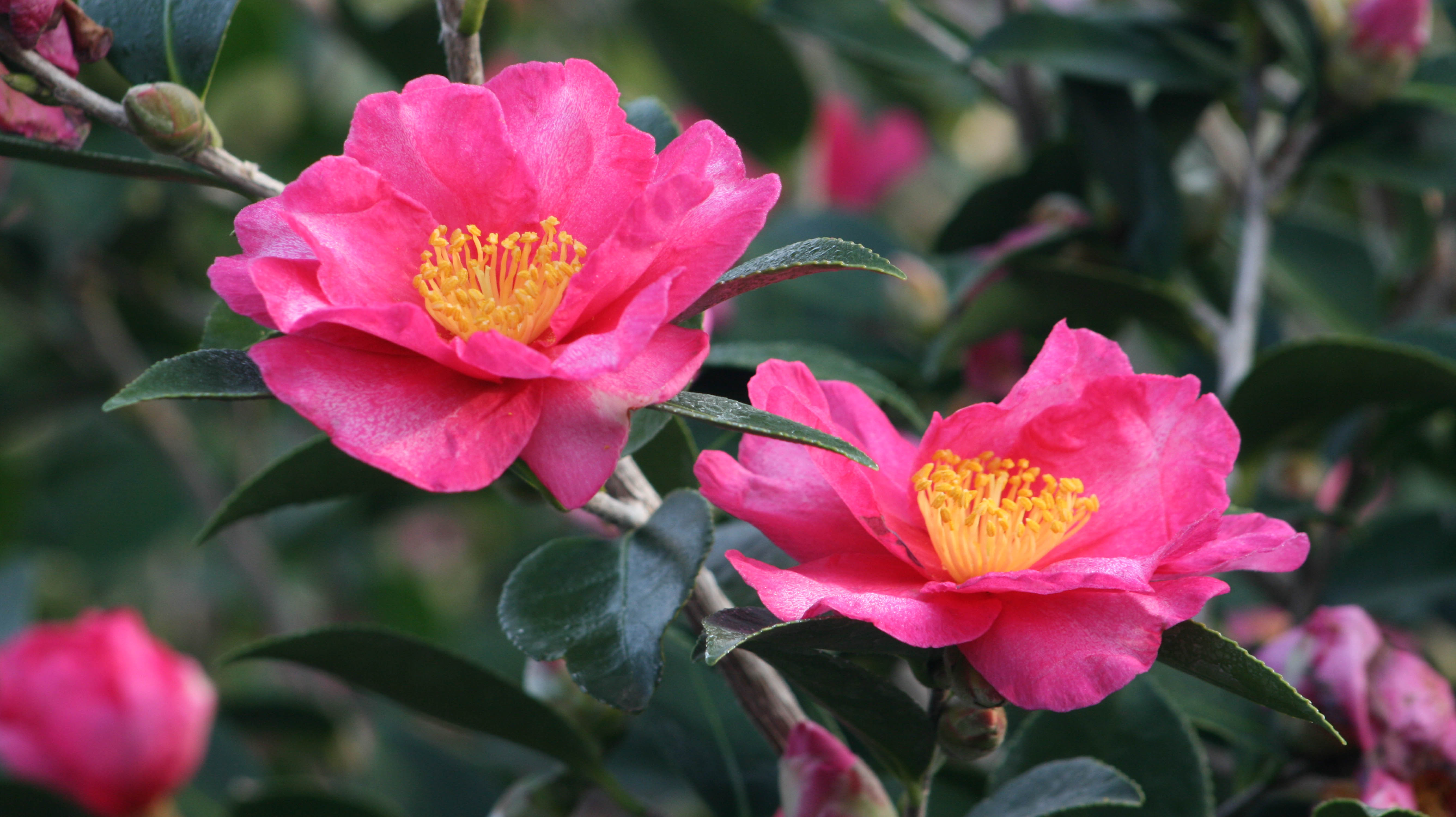
When, Why, and How to Prune Camellias
Choose the right camellia for the right spot—one where it has the room it needs to grow to maturity. Then, it should need little pruning, except for removing damaged, diseased, or dead stems. But when you do, follow the following tips to ensure a healthier plant and maximize its floral display.
When
- Regardless of whether your camellia is a sasanqua or a japonica, prune just after blooming has ended. You should avoid pruning in late summer so that you don’t remove next year's developing buds.
Why
- Thin out growth when it is so dense that flowers have room to open.
- Cut back top growth to make leggy shrubs bushier.
- Shorten lower limbs to encourage upright growth.
How
- When pruning, cut just above a scar that marks the end of the previous year's growth. (Often a slightly thickened, somewhat rough area where bark texture and color change slightly). Making your cuts just above this point usually forces three or four dominant buds into growth.
- Always use sharpened pruners. It's best practice to sterilize the blades between cuts to minimize the spreading of disease.
Winter Care for Camellias
If you live in an area where the temps drop below freezing, you may need to protect your camellias. Although many varieties of camellias are cold hardy, even they can be susceptible to winter damage, especially during extremely cold spells and from winter winds.
To minimize the impact of these harsh conditions, consider the following:
When to Fertilize Camellias
Camellias may need fertilizer to reach their fullest potential, but knowing when to fertilize is critical:
- Fertilize after the blooming season is over. Ideally, wait about a month to give all the flowers time to drop.
- Provide two or 3 applications of nitrogen-rich, slow-release fertilizer in early spring, late spring, and/or early summer.
- Don’t fertilize after August, as this may promote new growth that could be damaged in winter.
- Fertilizers with an NPK value of 12-4-8 or 16-4-8 work well. But to make it easier for you, there are fertilizers tailor-made for camellias and azaleas.
Too much of a good thing is not always a good thing, and such is the case with fertilizing camellias. Don’t overdo it, as too much nitrogen can cause leaves to yellow and drop off. Read the labels and apply fertilizers accordingly.
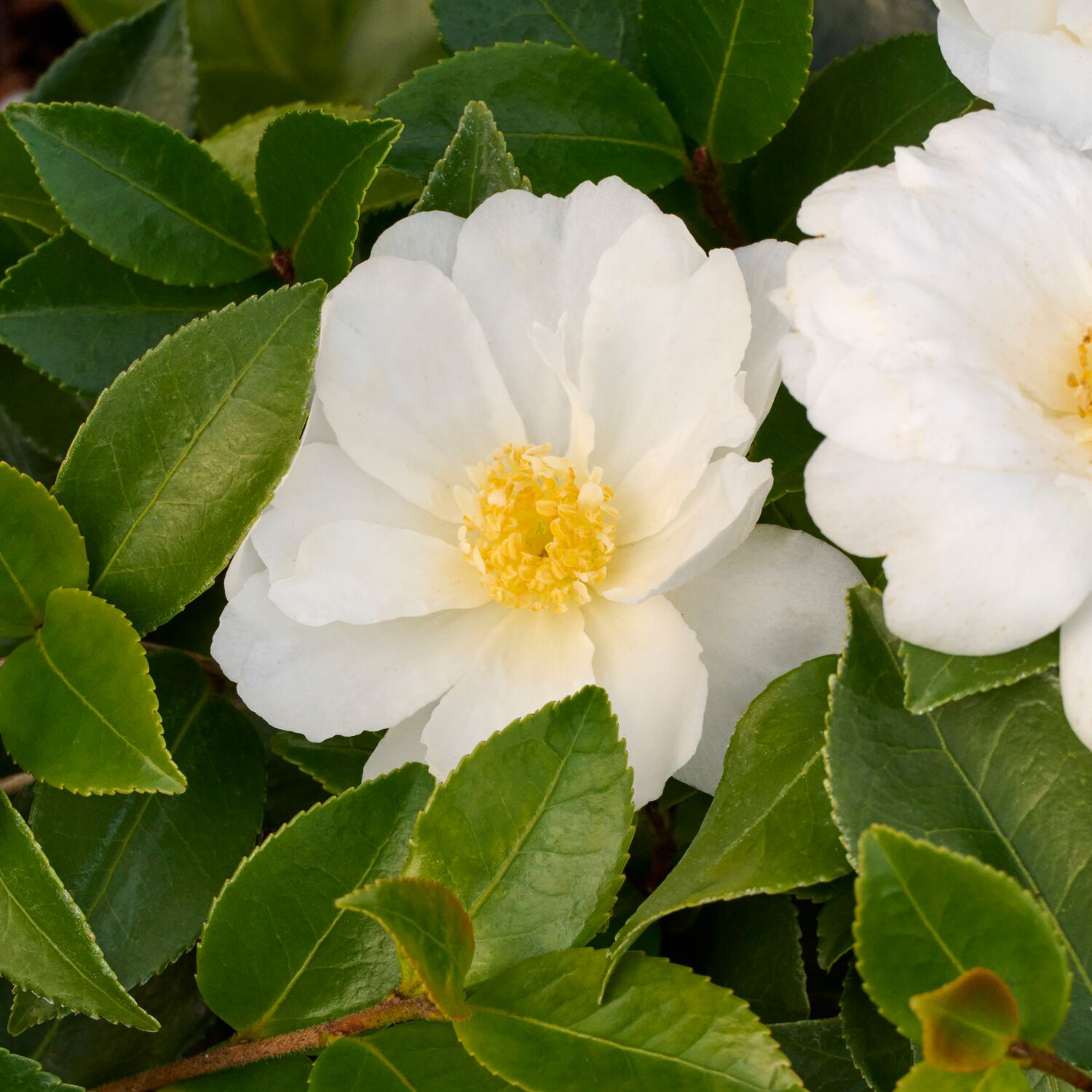
- Check the label to find a variety of camellia that’s particularly cold-hardy. The Ice Angels® series (including Winter's Snowman, April Remembered, and Spring's Promise) is especially well-suited for colder climates, offering up to a full zone more cold tolerance than traditional varieties.
- Avoid fertilizing camellias late in the summer so as to not encourage new growth. Also to ensure the foliage has hardened off before the winter comes.
- Protect your plants’ roots by adding a thin layer of mulch or organic matter.
- Loosely wrap your camellias with burlap or horticulture fleece during particularly cold times. Especially when temps are predicted to drop well below freezing. Double up if need be, but always make sure light can shine through. Remove once the temps warm up, but have everything on the ready for that late spring frost!
- Move potted camellias into a greenhouse, garage, or close to your home. Or, to some structure to protect them from the wind.
How to Protect Camellias from Frost
If you live in an area where the temps drop below freezing, you may need to protect your camellias. Although many varieties of camellias are cold hardy, even they can be susceptible to winter damage, especially during extremely cold spells and from winter winds. To minimize the impact of these harsh conditions, consider the following:
- Check the label to find a variety of camellia that’s particularly cold hardy.
- Avoid fertilizing camellias late in the summer so as to not encourage new growth. Also to ensure the foliage has hardened off before the winter comes.
- Protect your plants’ roots by adding a thin layer of mulch or organic matter.
- Loosely wrap your camellias with burlap or horticulture fleece during particularly cold times. Especially when temps are predicted to drop well below freezing. Double up if need be, but always make sure light can shine through. Remove once temps warm up, but have everything on-the-ready for that late spring frost!
- Move potted camellias into a greenhouse, garage, or close to your home. Or, to some structure to protect them from the wind.
Three More Trending Camellias
Setsugekka
Camellia
A sasanqua variety. Large, perfectly formed, semi-double, white flowers with ruffled edges and a bright center of golden stamens. Has a dense, semi-weeping habit and glossy, dark green foliage. Full shade to partial sun. Up to 10' tall and wide. Zones 7-10.
Nuccio's Bella
Rossa Camellia
An abundance of formal, four-inch, crimson red blooms open slowly over a long period for an especially long bloom season. Even young plants show an extra heavy bud set. Full shade to partial sun. Up to 8' tall and wide. Zones 8-10.
How to Grow Camellias in Pots
Yes, camellias can grow in pots – quite well, in fact. Potted camellias are a perfect choice for a patio or deck. Or use camellias in containers to frame an entrance or an inviting view. If you want to try your hand at growing camellias in pots, keep these tips in mind:
- As is always the case, make sure to choose a variety and size of camellia. One that fits the space it will be planted. Obviously, space in a container is more limited, so you’ll likely want to choose a dwarf variety.
- Since sasanquas are typically smaller and more heat- and sun- tolerant than japonicas, a sasanqua or hybrid that's more heat tolerant is your best bet. Chansonette's Blush Camellia is a great dwarf variety to consider.
5 tips for planting a potted camellia:
- Add a few inches of gravel at the bottom of the container to ensure proper drainage
- Sever off the taproot to encourage a wider, more fibrous root system
- Fill with a moisture-retentive potting mix
- If you can, choose a spot where your potted camellias can stay put. Although moving potted plants around is one of the advantages of planting in containers. Camellias don't take to change very well - and they'll tell you that by dropping their buds.
- The soil in containers dries out more quickly than the soil in other areas of your garden. So make sure to stay on top of your watering schedule.
Three Favorite Camellias for Containers
Yuletide
Camellia
A sasanqua variety. Single, brilliant red blooms centered with bright yellow stamens make an elegant statement in the winter garden. Monrovia's craftsman-trained espalier specimens are particularly striking in containers. Full shade to partial sun. Up to 10' tall and wide. Zones 7-10.
Debutante
Camellia
A japonica variety. Abundant, large, light pink, peony-style blooms are a delightful contrast to the glossy, dark green leaves. Perfect for milder regions, and one of the earliest to bloom. Perfect for large patio containers. Full to partial shade. Up to 8' tall and wide. Zones 8-10.
Swan Lake™
Camellia
A japonica variety. Very large, snow-white, semi-double, peony-like blooms contrast beautifully against the glossy, dark green foliage. Excellent as an evergreen specimen in a container. Full shade to partial sun. Up to 8' tall and wide. Zones 8-10.
Photo by Richard Shiell
Get More Plant Care Tips and Guides
- Sign up for the Grow Beautifully Newsletter. You'll get gardening tips, design advice, free digital guides, and live webinar invites. Plus, new, exclusive plant information delivered straight to your inbox twice a month.
- Hibiscus Care Guide
- Conifer Care Guide
- Boxwood Winter Care
- Azalea Care Guide
- Hydrangea Care Guide
- Top 10 Tips for Planting in Summer
- How to put Hydrangeas to Bed for Winter
- Our Top 10 Gardening Tips
- Guide to Pruning Flowering Shrubs
- How and When to Prune Hydrangeas
- Pruning Ornamental Grasses
- How and When to Prune Lavender
- Check out the "Garden Tips" section of the blog. Here there are care guides and garden tips on a wide array of plants.
About the Author and Designer
Doug Scott is the owner and lead designer at Redeem Your Ground, an exterior design firm, based in Atlanta, GA. Through his designs, Doug hopes to create outdoor spaces that reflect each client's wants to live outside at home. Doug and his wife, Brittany, also have a family, home & garden blog by the same name. They share stories, helpful information, and instructional how-to’s—hoping to enable and inspire others to live more fully at home.






